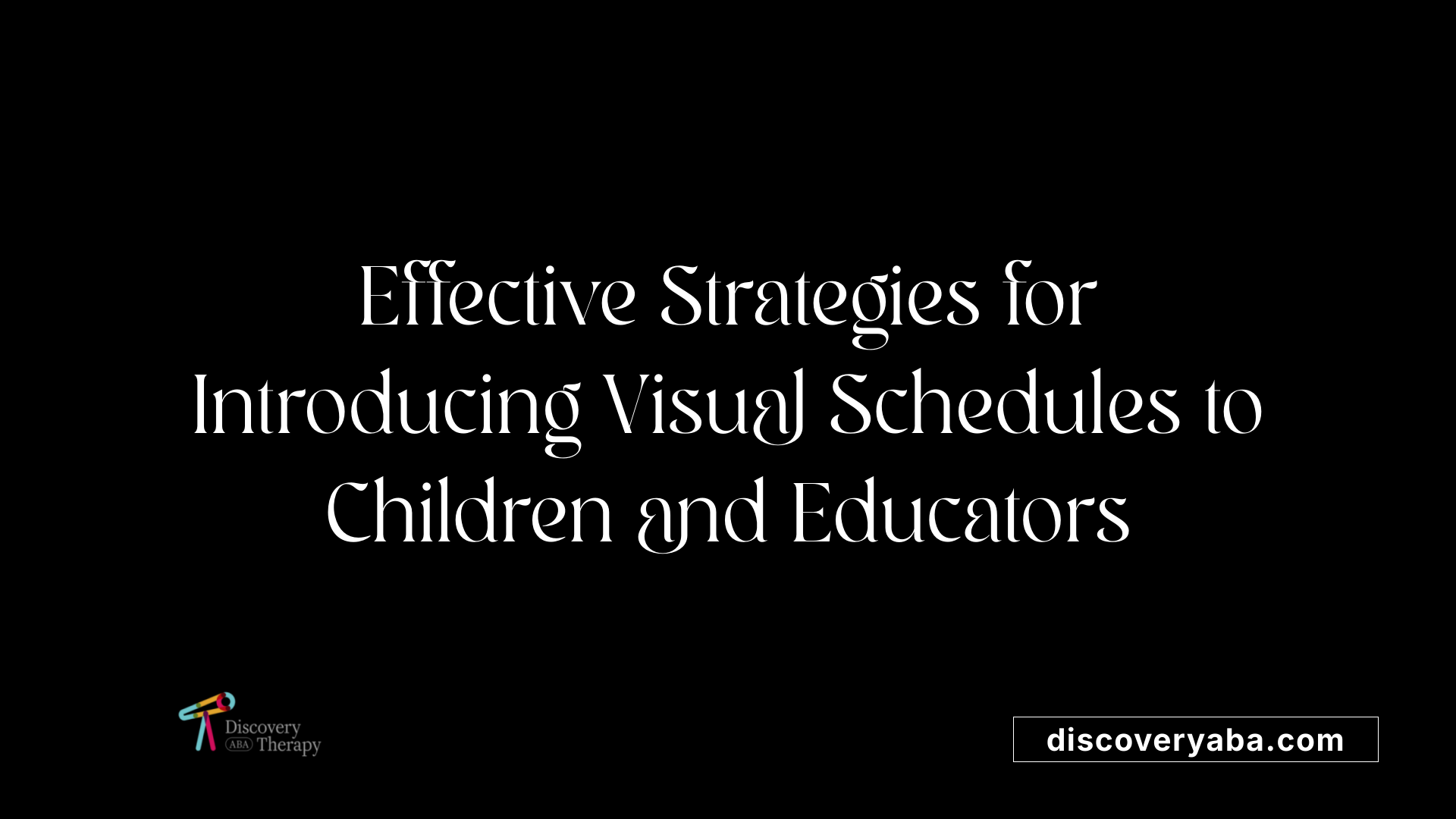How to Introduce Visual Schedules for Better Behavior Management
Unlocking Routine Success with Visual Schedules


Understanding the Power of Visual Supports in Behavior Management
Implementing visual schedules is an effective strategy to enhance behavior management, especially for children with autism and other developmental needs. These tools help provide clarity, predictability, and structure in daily routines, leading to reduced anxiety, improved understanding, and increased independence. This article offers a comprehensive guide on how to introduce and utilize visual schedules effectively, ensuring that caregivers and educators can maximize their benefits across various settings.
What Is a Visual Schedule and Why Is It Essential?

What is a visual schedule?
A visual schedule is a practical tool that uses pictures, symbols, or words to display a sequence of activities or tasks. It helps children understand what upcoming activities are, in what order they should occur, and how long they might last. By providing a clear outline of daily routines, visual schedules support children in following along independently, especially during transitions.
These schedules serve as visual reminders, reducing uncertainty and anxiety by making routines predictable. They can be composed of photographs, drawings, objects, or digital images. Designed to be used consistently, visual schedules assist children in managing their time, understanding expectations, and developing self-regulation skills.
While particularly beneficial for children with autism, speech delays, or sensory processing issues, they are also valuable for all children. Visual schedules foster communication, focus, and independence, making daily routines more manageable and less stressful. Overall, they are versatile tools that promote organized behavior and smoother transitions throughout the day.
Benefits of Visual Schedules in Behavior and Organization

What are the benefits of using visual schedules to improve behavior and organization?
Visual schedules are highly effective tools for enhancing behavior and organizational skills in children, especially those with special needs such as autism or ADHD. They serve as visual outlines of daily routines and activities, providing children with a sense of structure and predictability.
One of the primary advantages is reducing anxiety and stress. When children see a clear sequence of what will happen next, they experience less worry about unexpected changes. This sense of predictability helps calm nerves and smoothens transitions between different activities.
Moreover, visual schedules foster independence. Children learn to follow routines and manage their own activities with minimal adult prompts. By understanding what to do and when, they build confidence and develop important self-regulation skills.
These schedules also improve comprehension and communication. Using pictures, symbols, or words, they help children understand expectations and upcoming tasks, which is particularly valuable for visual learners or children with language processing difficulties.
In addition, visual schedules facilitate smoother transitions, decreasing resistance and meltdowns during activity changes. They promote positive behaviors by clearly illustrating consequences and expected actions, encouraging children to engage in appropriate activities.
In summary, visual schedules support greater organization, independence, and positive behavior, ultimately helping children navigate their daily routines more successfully and with less stress.
Step-by-Step Guide to Creating and Using Visual Schedules

Identifying Routines
Begin by pinpointing daily routines or specific skills that need support. These could include morning preparations, classroom activities, or self-care tasks. Breaking complex routines into clear, manageable steps helps children understand and anticipate their day.
Selecting Visuals
Choose visuals that suit the child's developmental level and learning style. Options include photographs, drawings, icons, or written words. Personalizing visuals with familiar images enhances engagement and comprehension.
Organizing Sequentially
Arrange the visuals in a logical order reflecting the daily flow. Use physical boards, digital apps, or laminated cards that are easy to manipulate. Ensure the sequence clearly illustrates what comes first, next, and last.
Introducing the Schedule
Gradually introduce the schedule to the child, explaining each visual and its meaning. Use verbal guidance and prompts, such as pointing or physical assistance if necessary. Practice following the schedule in a low-stress environment, offering praise for participation.
Teaching Independence
Encourage the child to manipulate the visuals independently. Start with simple actions like removing completed tasks or moving visual cards. Reinforce successful completion with positive feedback and, if appropriate, rewards. Keep the schedule accessible and visible to maximize independence.
Reviewing and Updating
Consistently review the schedule’s effectiveness. Observe the child's responses and adjust visuals, complexity, or sequence as needed. Update the schedule regularly to reflect changing routines, progress, or interests, ensuring it remains a helpful tool for the child's growth.
This systematic approach fosters routine comprehension, promotes independence, and reduces anxiety by providing children with predictable routines supported through personalized visual schedules.
Strategies for Introducing Visual Schedules to Children and Educators

Initial assessment and planning
Before implementing visual schedules, it is crucial to evaluate the individual needs of the child or student. This involves understanding their developmental level, learning preferences, and specific challenges, such as difficulties with communication or transitions. Based on this assessment, educators and caregivers can select appropriate visuals—whether pictures, symbols, or words—that are easily recognizable and meaningful for the individual. Planning also includes deciding which routines or activities to include initially, starting with simple and familiar tasks.
Gradual introduction and modeling
Introducing the schedule should be a slow process, emphasizing clear demonstration and practice. Begin by showing the visual schedule to the child, explaining each activity or step, and modeling how to follow it. Use verbal cues alongside the visuals to support comprehension. During initial sessions, guide the child through the schedule, providing physical or verbal prompts as needed. Over time, decrease prompts to foster independence.
Prompting and reinforcement
Effective prompting strategies include verbal hints, gestures, or physical guidance such as hand-over-hand assistance. Reinforcing correct use with praise, tokens, or preferred activities motivates children and encourages continued engagement. Consistent reinforcement helps establish positive associations with schedule use, making it a routine part of the day.
Consistent use and review
Consistency is vital for success. The schedule should be placed in an accessible spot, and staff should use it regularly to reinforce routines. The schedule must be reviewed often, with updates made to reflect changing interests, routines, or progress. Regular review ensures the schedule remains relevant and continues to meet the individual's evolving needs.
Involving caregivers and teachers
A collaborative approach enhances effectiveness. Caregivers and teachers should be involved in selecting visuals and setting goals for schedule use. Training families and staff on how to introduce and reinforce use at home and in various settings promotes generalization of skills. Sharing observations about what works best can help tailor the visual schedules for each child's context, maximizing benefits across environments.
In summary, introducing visual schedules involves thoughtful assessment, gradual introduction with modeling, prompt-based reinforcement, consistent application, and collaboration among caregivers and educators. These strategies collectively facilitate understanding, independence, and positive routines for children and students.
Adapting Visual Schedules for Different Needs and Settings

How can visual schedules be adapted and customized for different needs and environments?
Visual schedules are versatile tools that can be tailored to suit a wide range of individual and setting-specific requirements. Customization begins with selecting the most appropriate visual formats—these could include photographs, symbols, videos, or written words—depending on the individual's developmental level, sensory preferences, and reading abilities.
The content of the schedule should focus on breaking down activities into simple, manageable steps to build confidence and independence gradually. As individuals master these steps, the schedule can be expanded or made more complex to accommodate growing skills and routines.
Personalization plays a vital role in making visual schedules engaging and relevant. Using familiar images or photographs of the person performing tasks helps foster connection and enhances motivation. This familiarity encourages children and adults to follow the schedule more consistently.
Placement and accessibility are crucial. The schedule should be positioned in a visible and accessible location near the activity space, ensuring that the individual can easily refer to it without assistance. For example, a visual schedule on a wall at eye level or a portable device can facilitate smoother transitions and routine adherence.
Finally, ongoing monitoring and flexibility are essential to the success of visual schedules. Regular review allows caregivers and teachers to assess effectiveness, make necessary adjustments, and introduce new visuals as needs evolve. This dynamic approach ensures that the schedule remains a supportive and effective tool, adaptable to changing environments and individual growth.
In essence, customizing visual schedules involves thoughtful selection of visuals, deliberate organization of activities, strategic placement, and continuous updates to meet each person's unique needs. When these elements are aligned, visual schedules become powerful tools for fostering independence, reducing anxiety, and enhancing overall functioning across diverse settings.
Facilitating Transitions and Managing Challenges with Visual Supports
What are methods to facilitate transitions and reduce behavioral challenges with visual supports?
Using visual supports effectively can greatly improve how children manage transitions and address behavioral issues. A common strategy involves implementing visual schedules that clearly display the day's activities, giving children a predictable outline of what to expect next. This visual structure helps reduce anxiety and resistance.
In addition, timers that incorporate visual cues—such as color changes or countdown visuals—serve as visual signals that a transition is approaching. For example, a timer that turns red five minutes before a transition can prepare a child mentally, easing the change.
Breaking down complex tasks into smaller, manageable steps using visual aids like First/Then boards or social stories can motivate children to complete less preferred activities by offering clear expectations and a sense of control. These visual tools often show the sequence of activities, making it easier for children to understand and follow routines.
Offering choices and incorporating preferred items or activities during transitions encourage cooperation. For instance, allowing a child to choose between two preferred toys to carry to the next activity can make transition times smoother.
Consistent modeling and reinforcement are critical. Demonstrating how to use the visual supports, explaining their purpose, and praising children when they successfully follow the visuals reinforce positive behavior. Applying these strategies both at home and in other environments ensures a cohesive approach that supports independence and reduces behavioral challenges.
Empowering Independence and Positive Behaviors through Visual Support
Introducing visual schedules effectively requires careful planning, personalization, and consistent application. By understanding their benefits and employing strategic methods for creation and implementation, educators and caregivers can significantly improve behavioral outcomes and organizational skills. Customizing visual supports to meet individual needs and using them as part of a broader behavior management approach fosters independence, minimizes stress, and promotes positive self-regulation. Emphasizing gradual teaching, reinforcement, and regular review ensures that visual schedules remain an invaluable tool in fostering a structured, supportive environment where all children can thrive.
References
- How to Teach Students to Use Visual Schedules - How to ABA
- Using Visual Schedules to Help Kids with Autism: A Brief Guide
- The Ultimate Guide to Visual Schedules for the Classroom
- Creating a Visual Schedule: A Game-Changer for Behavior ...
- Visual Schedules in the School Setting | Reading Rockets
- Visual Schedule Series: First-Then Schedules (Freebie!!)
- The Power of Visual Schedules: Enhancing Learning and ...
- 4 Best Tips to Teach an Individual How to Use a Visual Schedule
- [PDF] Visual Schedule Tip Sheet
Find More Articles

Understanding the Principles of Positive Reinforcement

How ABA Therapy Supports Transitions Between Activities

How to Identify and Celebrate Small Successes in ABA Therapy Progress

How ABA Therapy Can Reduce Self-Injurious Behaviors

How ABA Therapy Supports Academic Success

The Importance of Early Signs Recognition and ABA Intervention

How ABA Therapy Helps Improve Comprehension and Listening Skills

How to Use Visual Schedules to Support Your Child’s ABA Goals

How ABA Therapy Supports Self-Help Skills Like Dressing and Eating

How ABA Therapy Supports Behavioral Success in Community Settings

How ABA Therapy Helps Build Independence in Daily Activities

Building Social Skills Through ABA Therapy Techniques

The Role of School-Based Behavior Intervention Plans (BIPs)

The Benefits of Scripting and Role-Playing in ABA Therapy

How to Help Your Child Develop Coping Strategies with ABA Therapy

How to Address Hyperactivity and Attention Challenges with ABA Therapy

How ABA Therapy Addresses Challenging Behaviors

The Importance of Social Skill Groups in ABA Therapy

The Role of Task Analysis in ABA Therapy for Teaching New Skills

How ABA Therapy Helps Improve Focus and Attention in the Classroom
%2520(1).jpeg)
Assessment Tools For People With Autism

Autism And Chronic Pain

How to Use Social Stories to Enhance ABA Therapy Outcomes

How ABA Therapy Helps Prepare Children for School Success

How School-Based ABA Therapy Can Improve Academic Performance

How to Address Resistance to ABA Therapy and Build Engagement

How to Use ABA Therapy to Develop Self-Help Skills in Daily Routines

How to Use Role-Playing in ABA Therapy for Skill Development

How to Handle Regression in Skills During ABA Therapy

How ABA Therapy Supports Social Communication Development

How to Find the Best ABA Therapy Provider for Your Child

How to Create a Reward System That Motivates Your Child in ABA Therapy

The Role of ABA Therapy in Preparing Children for Independent Living

How ABA Therapy Teaches Communication and Social Skills

How School-Based ABA Services Help Students with Autism Thrive

How ABA Therapy Helps Develop Patience and Waiting Skills

How to Support Your Child’s Social Interactions Using ABA Techniques

How ABA Therapy Addresses Anxiety and Fear Responses in Children

The Role of Play-Based ABA Therapy in Skill Development

How ABA Therapy Helps Build Confidence in Children with Autism

The Benefits of Center-Based ABA Therapy for School Readiness

The Role of ABA Therapy in Building Emotional Intelligence

How to Use Differential Reinforcement in ABA Therapy

Exploring Different ABA Techniques and Strategies

How to Prepare for IEP Meetings When Seeking ABA Therapy Support

How to Use ABA Therapy to Develop Resilience and Coping Mechanisms

How to Work with ABA Therapists to Set Realistic and Achievable Goals

How to Recognize Burnout in ABA Providers and Address It

The Connection Between ABA Therapy and Improved Social Skills

How ABA Therapy Helps Address Aggressive Behaviors
.jpeg)
Does Processed Food Cause Autism?

The Benefits of ABA Therapy for Adolescents with Autism

How to Reinforce ABA Strategies at Home for Consistent Progress

How to Create a Positive Learning Environment at Home with ABA

Autism And Dementia: The Connection and Differences

How ABA Therapy Supports a Lifetime of Learning and Growth

The Role of Functional Behavior Assessments in ABA

How ABA Therapy Helps with Anger Management Skills

How to Address Food Selectivity Using ABA Techniques

How ABA Therapy Supports a Smooth Transition to Middle and High School

How to Address Perseveration in ABA Therapy

The Role of Social Reinforcers in Motivating Positive Behavior

How to Navigate the Transition from ABA Therapy to School Support Services

How to Address Overstimulation and Meltdowns Using ABA Techniques

ABA for Anxiety in Adolescents with Autism

ABA for Autism and Defiant Disorder Breakthroughs

ABA for Behavioral Challenges in Autism

ABA for Picky Eating in Autism

ABA Intervention Techniques

ABA Reinforcement Methods

ABA Session Plans

ABA Strategies for Behavior Modification

Innovative ABA Therapy Activities for Growth

Exploring the ABA Therapy Age Limit Guidelines

ABA Therapy and Behavioral Assessment

ABA Therapy and Developmental Delays

ABA Therapy and Leisure Skills

ABA Therapy and Self Advocacy Skills

ABA Therapy Benefits

ABA Therapy for Autism Behavioral Health Programs

ABA Therapy for Autism Development Centers

ABA Therapy for Autism Treatment Services

ABA Therapy for High-Functioning Autism

ABA Therapy for OCD in Autism

ABA Therapy for Sensory Overload

ABA Therapy Near Me That Supports Medicaid

ABA Therapy Online Resources

A Closer Look at ABA Therapy Toys

ABA Therapy Training for Parents Unveiled

Actors with Autism

Strategies for Self-Esteem with ABA

Addressing Sensory Aversion in Autism

Addressing Sensory Seeking in Autism

Exploring Autism and Alternative Treatments: Alternative Paths to Progress

Exploring the Impact of Biomedical Interventions on Autism
.jpeg)
Autism And Bipolar Disorder

Exploring Complementary Therapies for Autism

Exploring the Impact of Equine Therapy on Autism: From Horses to Hope
Contact us
North Carolina, Tennessee, Nevada, New Jersey, Utah, Virginia
New Hampshire, Maine
Massachusetts, Indiana, Arizona, Georgia
.avif)


